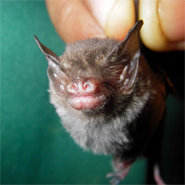Posted 11 November 2009
Key role for UCD scientist in world’s most ambitious study of animal evolution
An international consortium of scientists has announced its plans to map the DNA sequences of 10,000 vertebrate species including fish, birds, reptiles, amphibians and mammals. This is the most ambitious study of animal evolution ever attempted and will lead to the creation of a ‘genomic zoo’.
With evolutionary biologist, Dr Emma Teeling from the UCD School of Biology and Environmental Science as one of 68 scientists involved in the project, Ireland will be at the centre of the research. Dr Teeling’s work on the comparative study of bat genomes is known throughout the world. Her published works include the lead authorship of a paper in the prestigious journal Science; a groundbreaking work that rearranged the bat family tree.
The huge international study, known as the Genome 10K Project, will involve gathering specimens of thousands of animals from zoos, museums, and university collections worldwide, from which the scientists will sequence each genome to reveal the complete genetic heritage of each species.
“This is the most innovative and ambitious sequencing project ever conceived,” says Dr Teeling. “Ireland will be involved in driving 'mankinds' ability to sequence the full genetic compliment of organisms. We will be able to utilise our computational capacity through Grid Ireland and ICHEC to analyse the data. Irish scientists will become future leaders in comparative genomics and computational biology.”
The Genome 10K Project was conceived by Professor David Haussler from UC Santa Cruz, and a Howard Hughes Medical Institute investigator; Dr Stephen O’Brien, Chief of the laboratory of Genomic Diversity at the US National Cancer Institute; and Professor Oliver A Ryder, Director of Genetics at the San Diego Zoo’s Institute for Conservation Research and Adjunct Professor of Biology at UC San Diego.
“For the first time, we have a chance to really see evolution in action, caught in the act of changing whole genomes,” says Professor Haussler. “This is possible because the technology to sequence DNA is thousands of times more powerful now than it was just a decade ago, and is poised to get even more powerful very soon.”
According to Dr O’Brien, the cost of genome sequencing has been dropping steadily over the past decade, making the sequencing of 10,000 genomes a realistic possibility. “The original cost of sequencing the human genome by a major international consortium was over a billion dollars,” he says. “With the latest sequencing technology, it now costs $50,000 to $100,000 per genome. The price only needs to drop down another log or so to make the sequencing of 10,000 genomes possible.”
Among the authors is pioneering geneticist Professor Sydney Brenner, a Nobel Laureate and senior distinguished fellow at the Salk Institute. “The most challenging intellectual problem in biology for this century will be the reconstruction of our biological past so we can understand how complex organisms such as ourselves evolved,” says Brenner. “Genomes contain information from the past – they are molecular fossils – and having sequences from vertebrates will be an essential source of rich information.”
Now, the most challenging parts of the huge project announced in the Journal of Heredity on 05 November 2009 begin. The first challenge is to make the proposal a reality by getting samples, characterising them, conducting quality control on them, and delivering them to sequencing centres. The second challenge is to raise the money to pay for sequencing and analysis and annotation of the sequences.
(Produced by UCD University Relations)

